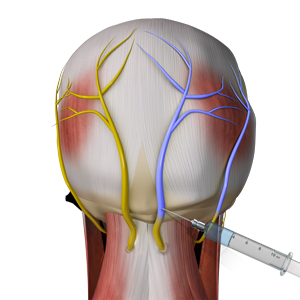
What are Occipital Nerve Blocks?
Occipital nerve blocks are a therapeutic procedure in which steroids and analgesic are injected into the occipital nerves present behind the head to treat headache and migraine that restricts normal activities.
Anatomy of the Occipital Nerves
The occipital nerves arise from the second and third spinal nerves in the neck (C2, C3). There are three types of occipital nerves – greater, lesser, and third occipital nerves. They run through the back of the head providing sensation to the scalp and part of the ears. Migraines or headaches are caused due to any irritation or inflammation in the occipital nerves.
Indications for Occipital Nerve Block
Indications for occipital nerve block include:
- Occipital neuralgia
- Chronic migraines
- Tension headaches
- Cluster headaches
- Cervicogenic headache
- Osteoarthritis of neck joint
- Tender scalp
- Pain from head trauma
Preparation for an Occipital Nerve Block
Your doctor will evaluate your physical health, medical history, and imaging studies to determine the site of injection. Preparations for the procedure include:
- Avoid eating or drinking 6 hours before the procedure.
- Do not stop taking your regular medications unless instructed by your doctor.
- Inform your doctor if you are allergic to any medications.
- You will need to change into a patient's gown.
- You should arrange for someone to drive you home.
Procedure for an Occipital Nerve Block
To perform an occipital nerve block:
- You will be instructed to sit or lie face down on the bed.
- Your vital signs are monitored throughout the procedure.
- The injection is usually performed at the back of the head above the hairline. A small patch of hair may be removed.
- The skin in that area will be cleaned with antiseptic and anesthetized to numb the area.
- Your doctor will then insert a small needle through the skin and inject a mixture of anti-inflammatory steroid medication and local anesthetic into the area of the occipital nerves.
- The injection can cause some irritation.
- The needle is then removed
- The whole process will take less than 10 minutes.
Some people experience pain relief in a few minutes of the procedure, but it may take a few days for others. If the first injection does not provide relief for one to two weeks, a second injection may be performed. Repeat injections may be necessary as the effect of the medications wear off, but you will not receive more than 3 injections in a 6-month period.
Post-Procedure for Occipital Nerve Block
After the procedure, you will be monitored for about 30-40 minutes. If there are no signs of discomfort or other complications you can return home. You should not perform any strenuous activities or driving for the first 24 hours. You may experience an ache at the injection site for a short while. Over-the-counter medications may be recommended for pain relief. Some people experience an increase in headaches which resolves as the steroids slowly begin to take effect. The effect increases over several days.
Risks and Complications of Optical Nerve Block
Risks and complications of occipital nerve block are rare, but can include:
- Infection at the site of the injection
- Pain and tenderness at the site of injection
- Soreness
- Bleeding or bruising
- Allergy to the medications
- No beneficial effect
- Neuroma due to nerve injury
- Facial palsy
- Severe headedness
- Light headedness
- Elevation in sugar level in diabetic patients
